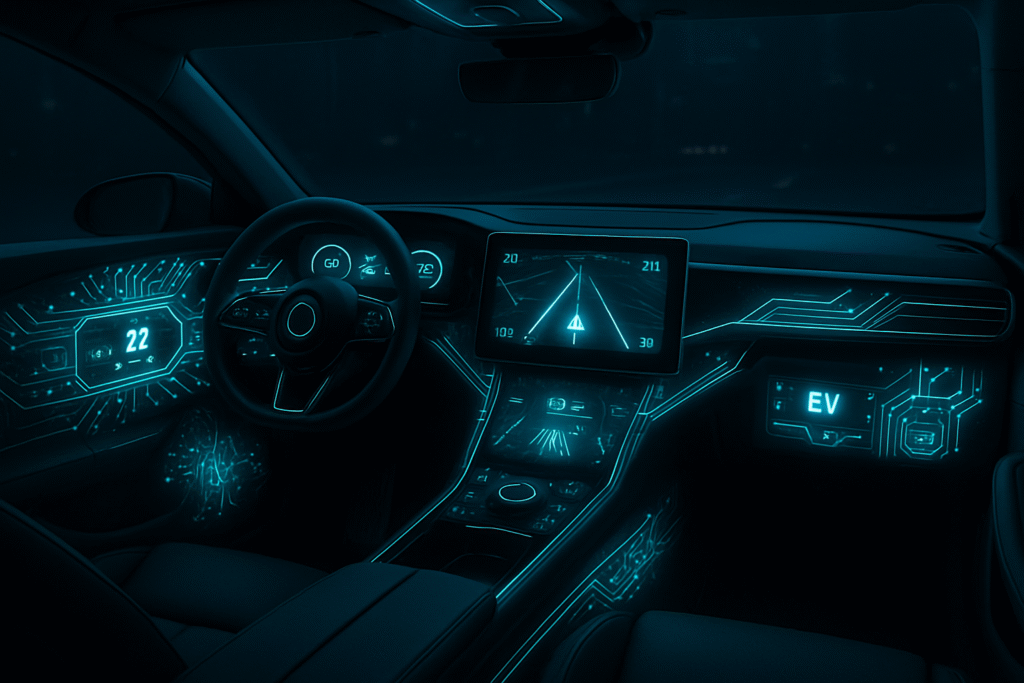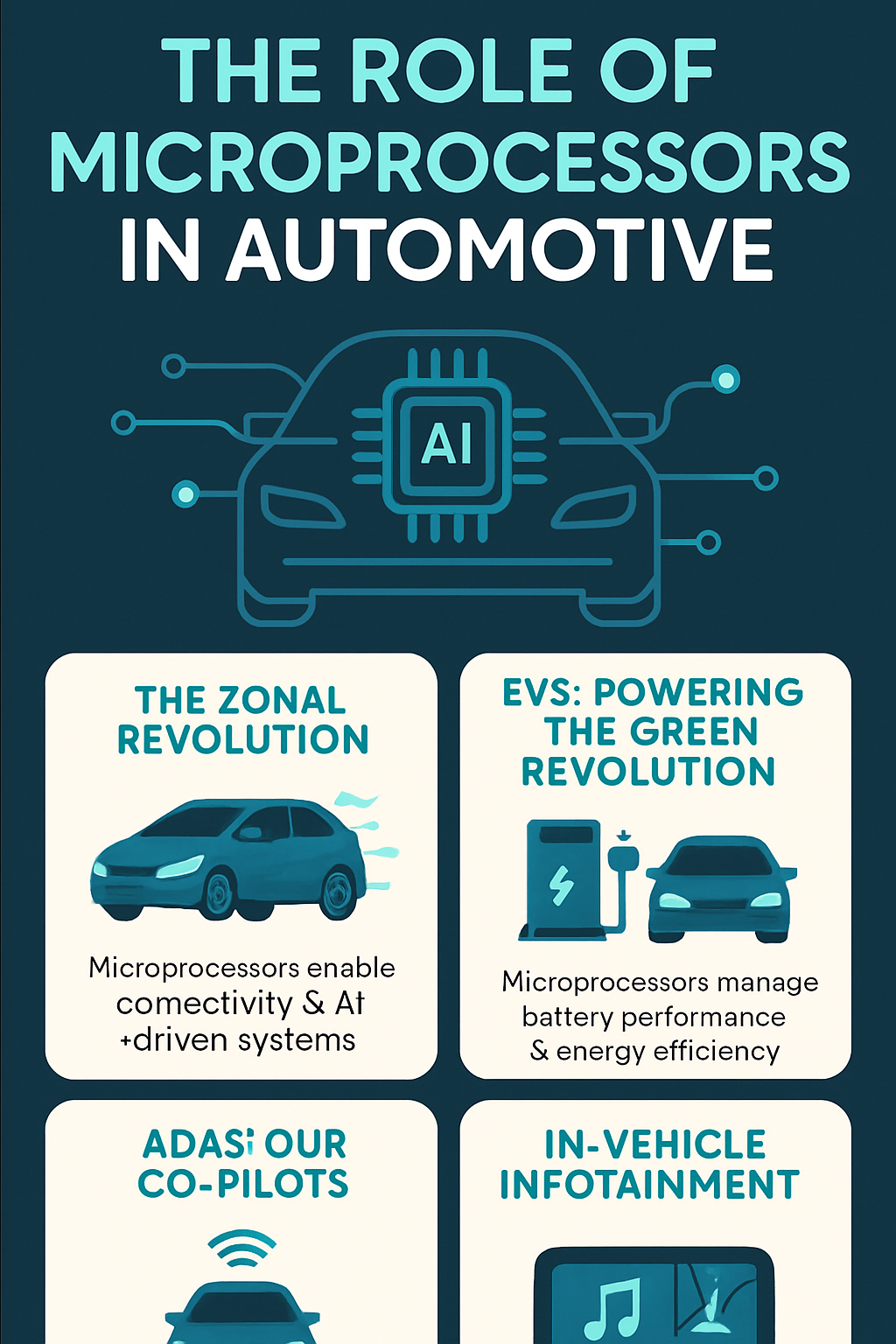
In the blink of an eye, our cars have transformed from mere mechanical marvels into sophisticated, rolling computers.
It’s truly incredible to witness!
This profound shift is largely thanks to the unsung heroes of modern automotive engineering: microprocessors.
These tiny powerhouses are not just enhancing performance; they are fundamentally reshaping how we drive, interact with our vehicles, and even how safe we feel on the road.
From the silent hum of an electric vehicle to the intelligent assistance of advanced driver-assistance systems, microprocessors are at the heart of every innovation.
Let’s dive into how these silicon brains are steering the future of the automotive world.

Videos are added as random thoughts 💭 💭 💭
The Zonal Revolution: A New Era of Vehicle Architecture
Remember the days when a car’s electrical system felt like a tangled spaghetti of wires and isolated control units?
Each function had its own dedicated Electronic Control Unit (ECU), leading to complexity and inefficiency. Well, those days are rapidly becoming a relic of the past.
Today, we’re witnessing a zonal revolution in automotive architecture [1].
This isn’t just a minor tweak; it’s a complete rethinking of how vehicle computing is organized.
Imagine a car where powerful domain controllers manage multiple functions within specific physical zones.
This approach mirrors the evolution of computing from distributed systems to cloud architecture, bringing similar benefits in efficiency and overall maintenance.
Tesla, for instance, is at the forefront of this transformation with its next-generation zonal controllers.
They’re utilizing innovative chiplet-based designs that combine advanced AI processing units for sensor fusion and decision-making with robust power management dies [1].
This consolidated approach dramatically reduces wiring complexity and cuts down on controller costs.
Of course, such revolutionary changes come with their own set of engineering challenges, particularly in managing thermal loads and ensuring seamless integration with existing systems.
Electric Vehicles (EVs): Powering the Green Revolution
Electric vehicles are more than just a mode of transport; they represent a significant leap towards a sustainable future.
And guess what?
Microprocessors are absolutely critical to their success.
If you’ve ever wondered what makes an EV so efficient and responsive, look no further than its intricate network of semiconductors.
These components are involved in almost every aspect of an EV’s operation, from managing power flow to ensuring battery longevity [2].
In power electronics, semiconductors meticulously control the flow of electrical energy between the battery pack, the electric motor, and other vital components.
They are also indispensable for the Battery Management System (BMS),
which constantly monitors the battery’s charge level, state of health, and temperature.
This ensures optimal performance and extends the battery’s lifespan.
Furthermore, microprocessors are crucial for onboard charging systems, converting and regulating voltage to enhance both the speed and efficiency of charging.
It’s fascinating to think that these tiny chips are making our journeys greener and more efficient.
It’s also worth noting the sheer volume of semiconductors in modern EVs.
While traditional internal combustion engine (ICE) vehicles might contain 300-1000 chips, newer EVs can house up to 3,000 semiconductors[2].
This significant increase reflects the growing complexity and advanced features packed into electric cars.
As vehicle technologies continue to evolve, demanding more sophisticated control and processing, this number is only set to rise.
Advanced Driver-Assistance Systems (ADAS): Our Co-Pilots on the Road
Have you ever felt your car gently steer you back into your lane or automatically brake to avoid a collision?
That’s ADAS at work, and it’s making our roads safer than ever before.
These systems are essentially our digital co-pilots, constantly monitoring the environment and assisting us in critical moments.
Microprocessors are the brains behind these life-saving technologies, processing vast amounts of data from various sensors in real-time.
ADAS features like adaptive cruise control, anti-collision systems, and automatic braking rely heavily on microprocessors to interpret data from cameras, lidar, and radar systems [2].
This sensor fusion is where the magic happens. NVIDIA’s Blackwell automotive platform, for example, represents a quantum leap in this area.
It integrates multiple data streams to create a coherent understanding of the vehicle’s environment, processing input from over a dozen cameras, radar units, and LiDAR sensors with remarkable efficiency [1].
This kind of processing power is what enables Level 4 autonomous driving capabilities, bringing us closer to a future where cars can truly drive themselves.
The demand for processing power in ADAS is only going to intensify as we move towards higher levels of autonomy.
The global ADAS-driven semiconductor market is projected to reach $39.4 billion by 2030,
highlighting the critical role these microprocessors play in the future of driving [3].
In-Vehicle Infotainment (IVI) Systems: The Connected Cabin
Beyond safety and efficiency, microprocessors are also transforming our in-car experience.
Modern in-vehicle infotainment (IVI) systems are far more than just radios; they are integrated multimedia hubs that keep us connected, entertained, and informed on the go.
Think about navigation, audio/video playback, communication functionalities, smartphone integration, and even vehicle customization controls – all powered by sophisticated microprocessors [2].
These systems demand high-performance processors capable of handling complex graphics, multiple displays, and seamless user interfaces.
AMD Ryzen™ Embedded processors, for instance, bring leading 3D graphics performance and 4K multimedia capabilities to IVI systems, making our journeys more enjoyable [4].
The ability to interact with our vehicles through voice commands, gesture controls, and augmented reality solutions is becoming increasingly common, all thanks to the continuous advancements in microprocessor technology.
The Connected Car: Security and the Future of Mobility
As vehicles become increasingly connected, forming nodes in a larger transportation network, the importance of secure communication cannot be overstated.
It’s as crucial as physical safety itself. Microprocessors are playing a pivotal role in ensuring that our connected cars are protected from cyber threats.
Processors like those in the Renesas RH850 family are incorporating quantum-resistant encryption and dedicated security cores to authenticate and encrypt messages,
all while meeting strict latency requirements for safety-critical communications [1].
This connectivity has far-reaching implications.
Imagine a scenario where a car detects black ice on a highway.
This information can be instantly and securely shared with nearby vehicles, preventing potential accidents.
The ability to share real-time data while simultaneously preventing malicious actors from injecting false information into the network is a testament to the advanced security features embedded within these microprocessors.
The Road Ahead: Challenges and Opportunities
The journey of microprocessors in automotive is far from over.
As we push the boundaries of what’s possible, new challenges and opportunities emerge.
The sheer complexity of integrating thousands of semiconductors, managing thermal loads, and ensuring robust security in a constantly evolving threat landscape requires continuous innovation.
However, the potential rewards – safer roads, cleaner environments, and more enjoyable driving experiences – are immense.
I believe we’re only just scratching the surface of what microprocessors can achieve in the automotive sector.
The future promises even more intelligent, autonomous, and connected vehicles, all driven by the relentless progress in semiconductor technology.
It’s an exciting time to be alive, and I can’t wait to see what innovations the road ahead holds!
References
[1] Octopart. (2025, March 17). *Silicon Drives: How Microprocessors Are Revolutionizing Automotive Architecture*. Retrieved from
[2] Rho Motion. (2024, April 30). *Semiconductors in EVs, what you need to know*. Retrieved from
[4] AMD. *In-Vehicle Experience*. Retrieved from
